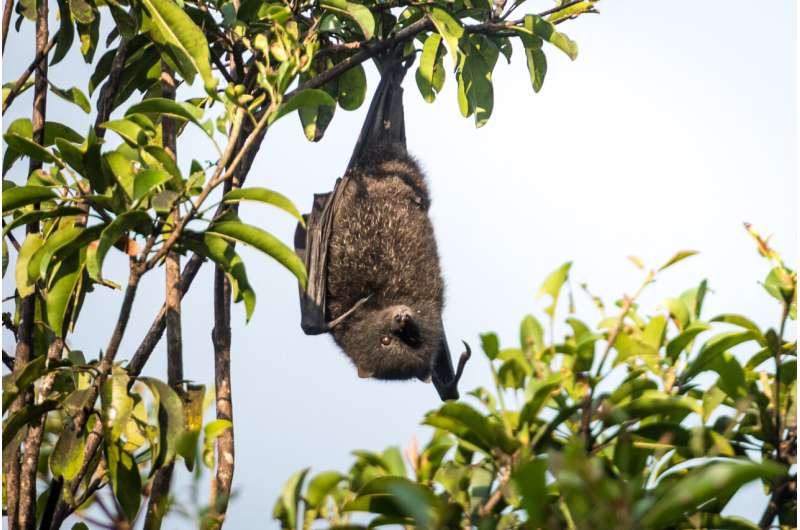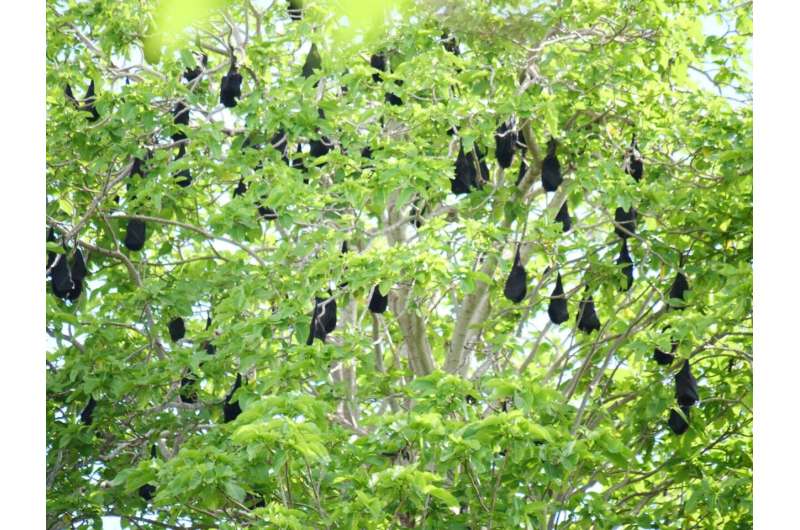'Alien' plants could pose risk to fruit bats

Led by the University of Sydney, a scientific team has analyzed the nutritional content of Christmas Island flying foxes' diets and found that introduced plant species do not provide a balanced meal.
The finding can be extrapolated to all flying foxes—also known as fruit bats—that feed on native and introduced vegetation. These include Sydney natives, the greyheaded and black flying-foxes.
With a population of just 3800, the Christmas Island flying fox (Pteropus natalis) is critically endangered. The only remaining native mammal species on the island, the fruit bat population was depleted by two-thirds between the 1980s and 2007. Possible causes of population decline include human-induced habitat loss and alteration, invasive animal species, and cadmium poisoning.
Altered habitats are often re-vegetated, including with introduced plant species, like mango, banana, soursop, breadfruit, and Japanese cherry trees. Yet, as the PLOS ONE study suggests, these introduced species may pose a further threat to the flying foxes' survival by not meeting their nutritional needs. "Our findings suggest that preserving these animals' complex foraging habitats is key to their conservation," said lead author, University of Sydney Ph.D. candidate Laura Pulscher. "If they went extinct, not only would we lose a native mammal, but the local ecosystem would be devasted, as they are a key pollinator and seed disperser on the island."
Introduced fruit not as nutritious
In 2018-19, the researchers collected and analyzed 125 native and non-native plant samples. These samples represented the most common plants on which the Christmas Island flying fox feeds.
"Compared to native fruit, introduced fruit had significantly more carbohydrates but lower mineral concentrations," said Ms Pulscher, from the Sydney School of Veterinary Science.
"Flying foxes may prefer to feed on introduced plants, as it makes it easier for them to meet their energy requirements in a shorter amount of time. They may also favor these plants as some—including papaya and Japanese cherry—fruit year-round on Christmas Island, when other food may be scarce. If this happens, flying foxes' nutritional requirements may not be met."

Ms Pulscher said that the flying foxes likely feed on fruit and nectar to meet their energy requirements, and pollen and native foliage like fig leaves to meet their protein and essential mineral needs. A diet encompassing a variety of native food plants is nutritionally optimum.
"The study results also support the need to include analyses of animals' diets in conservation plans generally," she said. "Animals that could benefit from such analyses include endangered primates, like the Eastern lowland gorilla."
More information: PLOS ONE (2021). DOI: 10.1371/journal.pone.0250857
Journal information: PLoS ONE
Provided by University of Sydney





















